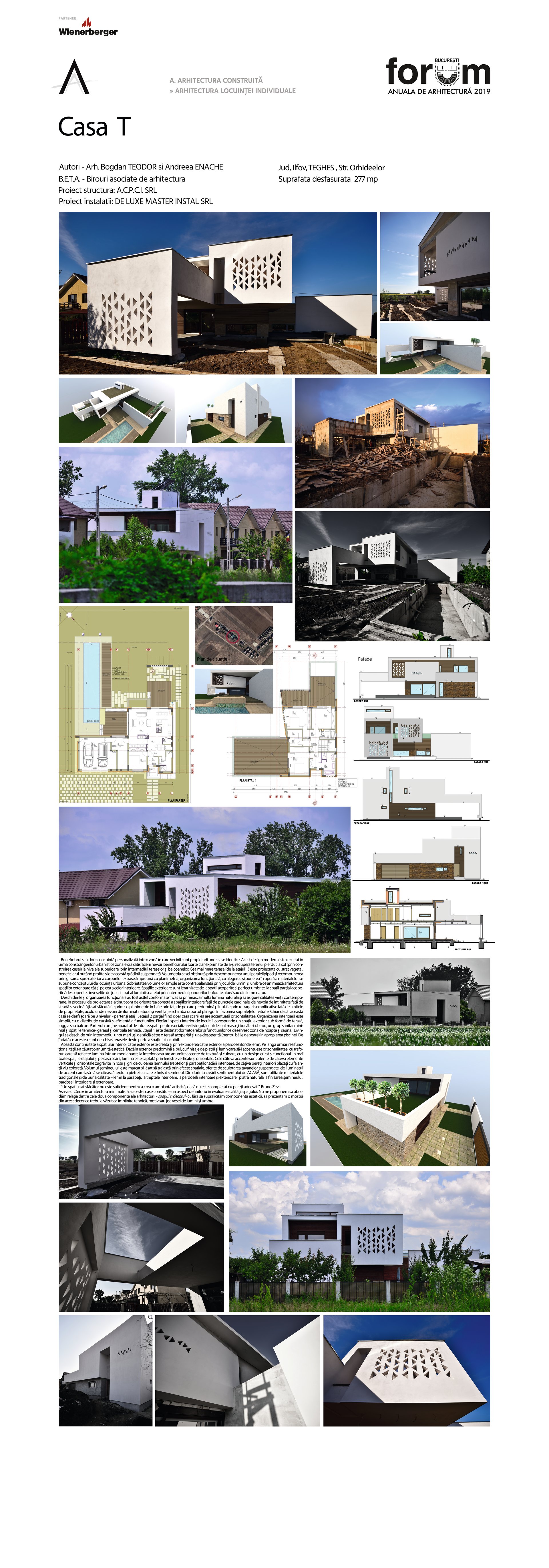
T-House

Authors’ Comment
The client wanted a personalized home in an area where neighbors are the owners of identical houses. This modern design is the result of urban zoning constraints and the satisfaction of the well-expressed beneficiary's need to recover the lost grass to the ground (by building the house) at higher levels through terraces and balconies. The largest terrace (from the 1st floor) is designed with vegetation layer, the client can also take advantage of this suspended garden. The volumetry of the house obtained by decomposing a parallelepiped and the recomposition by sliding the extracted bodies outwards, together with the planimetry, the functional organization, the choice and the putting into operation of the materials, are subject to the concept of urban dwelling. Sobriety of simple volumes is counterbalanced by the game of lights and shadows that anime the architecture of the exterior and interior spaces. The outer spaces are hierarchized from covered and perfectly shaded spaces, to partially covered / uncovered spaces, enchanted by the filtered sunlight game through white / or natural wood panels. The openings and functional organization have been complied (designed) so to receive much natural light and ensure the quality of contemporary life. The design process took into account the correct orientation of the interior spaces to the cardinal points, the need for privacy with the street and the neighborhoods, satisfied either by a L-planimetry or by facades dominated by fullness (masonry) or by significant distances to the property limits, where the request of natural lighting and ventilation changes the full-empty ratio in favor of glazed surfaces. Even if this house is on 3 levels - ground floor and 1st floor, the second floor is just the staircase, it has increased its horizontality. The internal organization is simple, with a smooth and efficient distribution of functions. Each indoor living space corresponds to an outdoor space in the form of a terrace, a loggia or a balcony. The ground floor contains entrance hall, socialization spaces: living room, dining room and kitchen, office, minimal sanitary group and technical spaces - garage and central heating. The 1st floor is designed for bedrooms and functions serving the night area and the sauna. The living room opens through large glass doors to a covered terrace and a sundeck near the pool. As soon as they are open, the terraces become part of the interior space. This continuity of interior space to the outside is also created by expanding the wooden floors to the outside. Besides functionality, a certain aesthetics was sought. If the white predominates outside, with stone and wood finishes that emphasize its horizontality, with perforated panels that reflect the light in a special way, inside the house has certain texture and color accents with a clean and functional design. In most of the first floor spaces and the staircase, light is captured through vertical and horizontal windows. The few accents are offered by some vertical and horizontal elements painted in red and gray, the color of the wood of the interior stairs and parapets, several interior walls painted with brightly colored tiles. The volume of the fireplace is marked and left to live by the space effects of sculpting suspended ceilings, accent lighting that lets you read the texture of the stone with which the fireplace is finished. With the desire to create the feeling of HOME, traditional and good quality materials are used - wood on the parapets, the interior stairs, the interior and exterior floors, the natural stone at the fireplace finishing, the interior and exterior floors. "A satisfaying space is not enough to create an artistic ambience if it is not filled with proper walls" -Bruno Zevi The so-called Decor in the minimalist architecture of this house is a defining aspect in assessing the quality of space. We do not intend to approach the relationship between the two components of architecture - space and decor - but without overestimating the aesthetic component, we present a sample of this decoration to be seen as a technical fulfillment, ornamental motif or cheerful play of lights and shadows.Related projects:
2019
Built Architecture
Individual House Architecture
Individual House Architecture
- E+E House
- Syaa House
- Private house
- Sfinții Voievozi 16 House
- Doja 36
- CMMT house
- Low-Rise Housing on Lake Floreasca
- NIU house
- House A
- House lake view
- House V
- GUD villa
- Single family house by the forest, Satu Mare
- DEH Duplex House
- Single-family home
- BEFORE & AFTER V02
- Villa Marina
- Single-family home
- T-House

